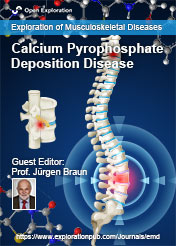-
Guest Editor
Prof. Jürgen Braun E-Mail
Rheumazentrum Ruhrgebiet, Ruhr Universität Bochum, Herne, Germany
Research Keywords: Rheumatoid arthritis, gout, osteoporosis
About the Special Issue
Calcium pyrophosphate deposition (CPPD) disease is a rather prevalent form of crystal-induced arthritis worldwide. Recently, the first classification criteria for this rheumatic musculoskeletal disease (RMD) which may present in rather heterogeneous clinical forms have been developed. These classification criteria for CPPD diseases have been validated by the European Alliance of Associations for Rheumatology (EULAR) and the American College of Rheumatology (ACR). For the classification as CPPD, the presence of a crowned dens syndrome or calcium pyrophosphate crystals in the synovial fluid in patients with joint pain, swelling or tenderness (entry criterion) whose symptoms cannot be fully explained by another rheumatic disease (exclusion criterion) is sufficient to classify an individual as a CPPD patient. In the absence of these findings, a score of more than 56 points based on weighted criteria consisting of clinical features, concomitant metabolic disorders such as and results of laboratory and imaging tests may be used to classify a person as having CPPD. CPPD is often found in the context of osteoarthritis. There is some overlap in the clinical presentations of CPPD disease and osteoarthritis, both relatively common with advanced age, diagnostic mimicry and co-occurrence by chance may occur. Some metabolic conditions such as hyperparathyroidism, hypomagnesemia, hypophosphatasia and hemochromatosis are known as risk factors for CPPD. A few patients with gout have CPP crystals in their synovial fluid which supports the hypothesis that these diseases share common local and systemic risk factors. Although most CPPD disease is sporadic, multiple kindreds with premature or extensive CPPD have been described worldwide. CPPD that occurs in patients younger than 60 years of age should lead to questions about similarly affected family members. At least two genetic loci are associated with familial CPPD.
CPPD is underdiagnosed and there are only a few therapeutic trials. Very recently colchicine was found to be as good as prednisolone with differences in the safety profile. This special issue was planned with the intention to spread decent scientific knowledge about the disease and the very promising recent achievements in the epidemiology and methodology of CPPD.
Keywords: CPPD, gout, classification criteria, synovial fluid analysis, crowned dens syndrome, acute arthritis, crystals, osteoarthritis
Call for Papers
Published Articles
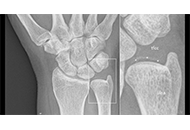 CPPD—differential diagnostics and differential therapeutic challengesOpen AccessReviewCalcium pyrophosphate deposition disease (CPPD), characterized by the presence of calcium pyrophosphate crystals in and around joints, poses diagnostic and therapeutic challenges in rheumatology. Th [...] Read more.Maria L. Voulgari, Herbert KellnerPublished: September 25, 2024 Explor Musculoskeletal Dis. 2024;2:443–460
CPPD—differential diagnostics and differential therapeutic challengesOpen AccessReviewCalcium pyrophosphate deposition disease (CPPD), characterized by the presence of calcium pyrophosphate crystals in and around joints, poses diagnostic and therapeutic challenges in rheumatology. Th [...] Read more.Maria L. Voulgari, Herbert KellnerPublished: September 25, 2024 Explor Musculoskeletal Dis. 2024;2:443–460
DOI: https://doi.org/10.37349/emd.2024.00069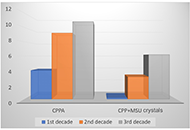 Prevalence and factors associated to calcium pyrophosphate arthritis in patients with goutOpen AccessOriginal ArticleAim: To ascertain the prevalence of calcium pyrophosphate arthritis (CPPA) at diagnosis and during follow-up of patients with gout. Methods: Inception cohort of patients with gout prospecti [...] Read more.Fernando Perez-Ruiz ... Frédéric LiotéPublished: September 10, 2024 Explor Musculoskeletal Dis. 2024;2:375–383
Prevalence and factors associated to calcium pyrophosphate arthritis in patients with goutOpen AccessOriginal ArticleAim: To ascertain the prevalence of calcium pyrophosphate arthritis (CPPA) at diagnosis and during follow-up of patients with gout. Methods: Inception cohort of patients with gout prospecti [...] Read more.Fernando Perez-Ruiz ... Frédéric LiotéPublished: September 10, 2024 Explor Musculoskeletal Dis. 2024;2:375–383
DOI: https://doi.org/10.37349/emd.2024.00063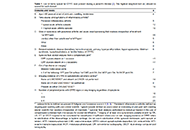 Calcium pyrophosphate deposition disease: points to be considered for quality assurance in clinical practiceOpen AccessReviewCalcium pyrophosphate deposition disease is known as crowned dens syndrome or peripheral arthritis, especially of knees, hips and shoulders. The disease course is asymptomatic, with acute or chronic [...] Read more.Michael Schirmer, Johannes Dominikus PalluaPublished: July 18, 2024 Explor Musculoskeletal Dis. 2024;2:270–278
Calcium pyrophosphate deposition disease: points to be considered for quality assurance in clinical practiceOpen AccessReviewCalcium pyrophosphate deposition disease is known as crowned dens syndrome or peripheral arthritis, especially of knees, hips and shoulders. The disease course is asymptomatic, with acute or chronic [...] Read more.Michael Schirmer, Johannes Dominikus PalluaPublished: July 18, 2024 Explor Musculoskeletal Dis. 2024;2:270–278
DOI: https://doi.org/10.37349/emd.2024.00055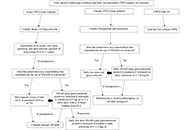 Treatment strategies for calcium pyrophosphate deposition diseaseOpen AccessReviewCalcium pyrophosphate deposition disease (CPPD) is a cause of inflammatory arthropathy that increases in prevalence with increasing age, presents in acute and chronic forms, and is characterized by [...] Read more.Anna J. Turlej, Angelo L. GaffoPublished: July 19, 2024 Explor Musculoskeletal Dis. 2024;2:279–292
Treatment strategies for calcium pyrophosphate deposition diseaseOpen AccessReviewCalcium pyrophosphate deposition disease (CPPD) is a cause of inflammatory arthropathy that increases in prevalence with increasing age, presents in acute and chronic forms, and is characterized by [...] Read more.Anna J. Turlej, Angelo L. GaffoPublished: July 19, 2024 Explor Musculoskeletal Dis. 2024;2:279–292
DOI: https://doi.org/10.37349/emd.2024.00056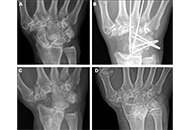 Progression of arthritis after four-corner fusion in patients with calcium pyrophosphate deposition disease: a case series of eleven patientsOpen AccessOriginal ArticleAim: The purpose of this study is to evaluate outcomes and radiographic progression of wrist arthritis after four-corner fusion (4CF) in patients with evidence of calcium pyrophosphate deposition [...] Read more.John F. Hoy ... Xavier C. SimcockPublished: July 10, 2024 Explor Musculoskeletal Dis. 2024;2:256–263
Progression of arthritis after four-corner fusion in patients with calcium pyrophosphate deposition disease: a case series of eleven patientsOpen AccessOriginal ArticleAim: The purpose of this study is to evaluate outcomes and radiographic progression of wrist arthritis after four-corner fusion (4CF) in patients with evidence of calcium pyrophosphate deposition [...] Read more.John F. Hoy ... Xavier C. SimcockPublished: July 10, 2024 Explor Musculoskeletal Dis. 2024;2:256–263
DOI: https://doi.org/10.37349/emd.2024.00053 Calcium pyrophosphate crystal deposition disease—what’s new?Open AccessEditorialJürgen BraunPublished: December 06, 2023 Explor Musculoskeletal Dis. 2023;1:257–263
Calcium pyrophosphate crystal deposition disease—what’s new?Open AccessEditorialJürgen BraunPublished: December 06, 2023 Explor Musculoskeletal Dis. 2023;1:257–263
DOI: https://doi.org/10.37349/emd.2023.00027 -
-
Ongoing Special Issues
-
Completed Special Issues
